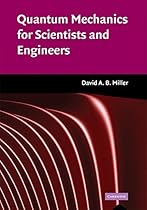Quantum Mechanics for Scientists and Engineers

| Author | : | |
| Rating | : | 4.50 (849 Votes) |
| Asin | : | 0521897831 |
| Format Type | : | paperback |
| Number of Pages | : | 568 Pages |
| Publish Date | : | 2013-06-06 |
| Language | : | English |
DESCRIPTION:
Each chapter closes with a review of terms used. Sadanand, Central Connecticut State University for Choice Magazine . "This is an excellent introductory-level textbook on quantum mechanics for physicists and engineers. " Shun Lien Chuang, Robert MacClinchie Distinguished Professor, University of Illinois, Urbana-Champaign"I think this is an excellent book. It will become my standard reference for text for quantum mechanics and I will expect to see it on the shelves of my PhD students as well as undergraduate students. He continues with approximation methods, perturbation theory, quanta in crystalline materials, various matrices, harmonic oscillators and photons, and fermions. Miller ends
Miller received the B.Sc. He is currently the W. . B. He has published more than 200 scientific papers, holds 62 patents, is a Fellow of OSA, IEEE, APS, and the Royal Societies of Edinburgh and London, holds honorary degrees from the Vrije Universiteit Brussel and Heriot-Watt University, and has received numerous awards. David A. His research interests include physics and devices in nanophotonics, nanometallic
Additional resources available from cambridge/9780521897839.. The many worked examples and more than 160 homework problems help students to problem solve and to practice applications of theory. More advanced subjects, such as density matrices, quantum optics, and quantum information, are also covered. Students will appreciate the book's applied emphasis, which illustrates theoretical concepts with examples of nanostructured materials, optics, and semiconductor devices. Without assuming a prior knowledge of high-level physics or classical mechanics, the text introduces Schrodinger's equation, operators, and approximation methods. Systems, including the hydrogen atom and crystalline materials, are analyzed in detail. Practical applications and algorithms for the computational analysis of simple structures make this an ideal introduction to quantum mechanics for students of engineering, physics, nanotechnology, and other disciplines. If you need a book that relates the core principles of quantum mechanics to modern applications in engineering, physics, and nanotechnology, this is it
Robert C said Well-Written and Not Confusing, Extremely Complete. Many textbooks, in general, suffer in readability due to the author assuming the reader thinks just as he or she does, or knows a sufficient amount of information prior to reading. David Miller is one of those authors that is just the opposite: he never assumes you know anything that isn't in his book (other than that you know how to read and do basic math). In addition, Miller has the unique . Super Book and supplemental text. Anthony Reid Super book, but it paid to know something about quantum physics first since the "key" algebra can be quite involved. As D. Miller said in online course lecture, your need to be reading 5 or 6 books at once to make more sense out of the subject matter.. "A clear and honest guide to quantum mechanics" according to J. Jean. This is a textbook like no other: Clear. Honest. Eloquent. Thorough. Typo-free. Readable.Reading Quantum Mechanics for Scientists and Engineers feels like nothing more than a friendly chat with Dave Miller about the nature of the universe. This year, as an undergrad EE major at Stanford, I took the quantum mechanics course from which this book emerged, using the book as a primary textbook and
